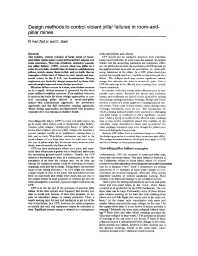Mining Publication: Design Methods to Control Violent Pillar Failures in Room-and-Pillar Mines
Original creation date: September 1997
The sudden, violent collapse of large areas of room-and-pillar mines poses a special hazard for miners and mine operators. This type of failure, termed a ‘cascading pillar failure' (CPF), occurs when one pillar in a mine layout falls, transferring its load to neighboring pillars, which causes them to fail, and so forth. Recent examples of this kind of failure in coal, metal and non-metal mines in the U.S.A. are documented. Mining engineers can limit the danger presented by these failures through improved mine design practices. Whether failure occurs in a slow, non-violent manner or in a rapid, violent manner is governed by the local mine stiffness stability criterion. This stability criterion is used as the basis for three design approaches to control cascading pillar failure in room-and-pillar mines the containment approach, the prevention approach and the full extraction mining approach. These design approaches are illustrated with practical examples for coal mining at shallow depth.
Authors: RK Zipf, C Mark
Peer Reviewed Journal Article - September 1997
NIOSHTIC2 Number: 20022911
Inst Min Metall, Trans, Sect A: Min Ind, 1997 Sep 106():A124-A132
See Also
- ALPS - Analysis of Longwall Pillar Stability - 5.4.02
- AMSS - Analysis of Multiple Seam Stability - 2.1.02
- ARMPS - Analysis of Retreat Mining Pillar Stability - 6.2.02
- Coal Mine Bumps: Five Case Studies in the Eastern United States
- Pillar Design Issues for Underground Stone Mines
- Proceedings: New Technology for Ground Control in Retreat Mining
- The State-of-the-Art in Coal Pillar Design
- Technology News 516 - ARMPS-HWM: New Software for Sizing Pillars for Highwall Mining
- Toward Pillar Design To Prevent Collapse of Room-and-Pillar Mines
- Using the Coal Mine Roof Rating (CMRR) to Assess Roof Stability in U.S. Coal Mines
- Content source: National Institute for Occupational Safety and Health, Mining Program


 ShareCompartir
ShareCompartir
